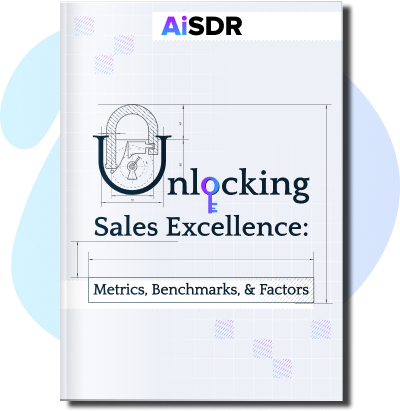How to Generate High-Intent B2B Leads That Transform into 50+ Successful Meetings Each Month

Find out how you identify and generate high-intent B2B leads
Picture your ideal month in sales: Your calendar is full of meetings, but not just any meetings. These are conversations with B2B leads who already understand which problems they need help with (most likely from you!).
This is a realistic scenario with the right approach, and here’s the blueprint.
What are high-intent leads?
Pulled from the book of intent-based marketing, high-intent leads are prospects that want to do business with you.
You know this because they clearly demonstrate an eagerness to take the next step with you. They purposefully browse your website, give meaningful responses to your follow-up messages, and engage with you after showing initial interest. Chances are they’ve downloaded content from your website or booked a demo.
This is in contrast to low-intent leads, which may have incidentally entered your sales pipeline by visiting your blog or meeting you at a conference. To transform them into a high-intent lead, you’ll need to run plenty of nurturing.
Signs you’re dealing with high-intent prospects
High-intent prospects typically check off most of these boxes.
They openly communicate
Real intent can be evident in every message. Your prospects repeatedly reach out with specific questions. They readily discuss their pain points and strategic goals and engage other decision-makers in their company.
Every action moves the process forward.
They regularly visit converting web pages
Both casual visitors and high-intent prospects may visit blog posts and pages with purchase-related content. They may arrive via organic search, paid ads, or your marketing emails.
But leads who are most likely to convert are distinguished by returning to these materials multiple times. You’ll also notice engagement from other decision-makers in their organization.
You’ll catch them reading customer reviews, exploring pricing pages, and looking through your case studies.
High-intent leads spend significant time and effort learning about your solution.
They download resources like buyer’s guides
Not only do they read, but they also interact with content that directly supports their buying decision.
These prospects might start with a buyer’s guide to understand key features, move on to case studies to see your niche expertise in action, and finish with technical documentation to make sure you’re a good match for their company.
They compare vendors on review sites
People looking to buy also tend to visit third-party review sites to compare your products or services with those of your competitors. You can monitor when they click from the competitions’ platforms to your website.
During sales conversations, questions like “I saw your prices are different from Competitor X — what extra value will we get?” will confirm that they’re doing their research.
They show up to demos prepared
Finally, high-value prospects attend your demos. The meeting starts on time, and all the important decision-makers are in the room. They ask questions, take notes, and request examples.
You’ll notice that they link every feature of your product to their needs—that’s a definite clue your B2B leads are already considering how your product fits in with their processes.
By connecting these data points — the number of pricing page visits, buyer’s guide downloads, specific competitor mentions, and demo requests — you can understand how close your B2B leads are to the bottom of the sales funnel.
You can create your own qualification checklist, prioritizing signals that have historically led to successful deals.
And now, we come to our blueprint. Let’s look at how to attract these high-quality B2B leads and convert them into customers.
Become an expert at understanding your customer
It all starts with knowing who you’re trying to reach. This knowledge changes everything—it impacts the content strategies you develop and the language you use when speaking to your B2B leads. Begin by creating an ideal customer profile (ICP) and buyer persona.
Nail down your ICP and buyer persona
Your ideal customer profile is a picture of companies that get the most value from your product and buy it fastest. These are the customers who enjoy your product and recommend it to others.
Certain characteristics are common among great customers: they work in similar industries, have specific revenue levels, use particular tech, and try to address related challenges. And, of course, their budgets align with your pricing.
Inside these ideal companies, you’ll find your actual buyer—a buyer persona. This can be an account executive, chief sales officer, or chief executive officer. It’s a specific person with their vision of success and the power to say “yes” to the purchase (i.e., the person who approves it).
A perfect match happens when you find your buyer persona inside your ideal company.
How do you find the perfect match?
- Study your best current customers.
- Notice which companies close fastest and stay loyal longest. Inside these companies, track your product’s target user, who influences the decision to buy, and who signs the contract.
- Use their firmographics, demographics, and psychographics to focus your marketing and sales tactics around similar buyers.
- Always speak to people, not companies, since they’re the ones who make decisions.
Creating detailed ICPs and buyer personas takes time. But this will help you target your marketing and shorten sales conversations.
If you find this task too tedious, try using AI for sales prospecting. AI tools can analyze your CRM data to detect patterns shared by successful deals.
Collect as much customer data as possible
Now that you know your ICP and buyer persona, you can start generating corresponding B2B leads.
Finding perfect customers starts with research. Two sources help you determine your leads’ level of interest: first-party data and third-party data.
First-party, or internal lead intent data, comes from your communication and social media channels. It reflects how prospects interact with your website, emails, and LinkedIn profiles.
Tools like Google Analytics help you monitor website behavior, like the number of page visits, users by country, time spent on the site, session conversion rates, and more. Platforms like HubSpot, Marketo, and Pardot let you see how B2B leads interact with your emails. LinkedIn Analytics lets you find out who views your company’s updates.
Third-party, or external, intent data gives you a broader view of buyers’ interest and lets you proactively spot them before prospects even reach your website.
Some sales automation tools track user activity online to reveal the topics users research and the content they download. You can then correlate this data with the probable prospect’s challenges. Just make sure the platforms you use gather ethically sourced data.
And remember to check out the company’s history and news. If they have recently opened a new office or launched a new product, they might have fresh needs you can address.
Use account-based marketing
Knowledge of your ICP, buyer personas, and customer behavior patterns lets you create content that speaks directly to businesses’ needs. This approach is called account-based marketing (ABM). Instead of publishing generic content and hoping for the best, you develop materials specifically made for your buyer personas.
Consider the following content types for your ABM efforts:
- Case studies: These work because you’re sharing real stories with which your buyer personas can identify. When they see how companies similar to their own succeeded with your solution, it makes the potential benefits feel real. Real numbers from challenges and outcomes in their own industry are much more compelling than vague promises.
- Comparison guides: These guides that compare your product or service with your competitors help prospects make confident decisions. High-intent leads often research several options — they want to get it right. Comparisons that break down features, pricing, and advantages give them the clarity they need. However, be honest about competitors’ strengths. Keep your guide unbiased to build trust.
- Buyer’s guides: A buyer’s guide aims to walk prospects through every step of choosing a solution. Explain what to consider first, which stakeholders to bring on board, and how to measure success. Buyer’s guides also list all the must-haves of a potential solution. These include essential features, what kind of support your lead would need, and more.
Making great content is only the beginning. After that, you need to make sure your potential customers can easily find it when they need it. Here’s where SEO comes in.
Optimize for intent-based searches. Your content should pop up when a prospect searches the internet for a product comparison or an ROI calculator. You’ll capture leads who actively evaluate options, and they’ll gladly schedule a meeting with you.
Plus, you can attach these materials during your cold outreach as well.
Iron out your B2B sales messaging strategy
Sharp content helped you generate more quality B2B leads, whereas intent data helped you qualify them. Now it’s time to act and start growing your pipeline.
But where will you engage with these high-intent leads, and how will you keep the conversation going?
Go omnichannel
Connect with your buyer personas on different platforms like email, LinkedIn, Meta, and others. McKinsey reports that 72% of customers will search for other vendors if they can’t buy through any point of contact.
Note that just using one channel for each buyer won’t cut it: 72% of customers also say they want a consistent experience across channels.
This means being present and responsive and maintaining a single repository with all the data at your fingertips wherever your customers interact with you, whether through contact forms, website chatbots, emails, calls, or any other channel.
Learn to speak their language
Simply put, talk like they talk. This demonstrates you’ve worked in and know their industry, just like you claimed. That adds trust points.
The best way to learn their language is to listen to your prospects. Pay attention to email threads and sales calls and notice the exact terms they use to describe their challenges and goals. Use that language with new leads within the same ICP.
Research company niches for the technical jargon and KPIs your B2B leads mostly use. Healthcare worries about HIPAA; retail may crave the Amazon Selling Partner API. B2B SaaS sales teams focus on monthly recurring revenue; wholesalers care about average order value.
What’s more, knowing the language of your buyer persona helps avoid any misunderstandings that can slow down the sales process or even grind it to a halt.
You could give a lengthy explanation of how your tool automates tasks, but your product’s true value might get lost among technical jargon, and buyers who aren’t well-versed in technology may quickly lose interest.
Why not just show how it reduces operational costs by 25%? Not only do you emphasize the product’s value in concrete terms, but you also tackle any concerns about your product’s ROI head-on.
Technical personas would rather learn about mechanisms that deliver these results and whether the product is compatible with their infrastructure.
Let an AI sales assistant learn from and act for you…
…And you’ll just reap the rewards.
You can totally control the quality of your lead management. But how about when it comes to quantity?
81% of sales teams have begun to or fully implemented AI. While they’re boosting their lead-to-appointment/demo ratios, you might still be at the stage of assessing lead intent. So, time is of the essence.
Here’s how generative AI-based sales automation tools can optimize your sales workflows:
- They research your market more efficiently, in less time, with more data. AI sales rep software can run automated surveys, process interview responses, and validate your assumptions quickly.
- They create messages that match a lead’s intent level. Smart B2B sales tools like AiSDR can connect with your HubSpot or other CRM data to understand where each lead stands. Whether prospects are just beginning to explore or are ready to buy, AI assistants deliver the right message at the right time and always remember to follow up.
- They bolster ABM efforts. AI-driven sales automation software can segment your market, identify key decision-makers, measure campaign success, and much more.
- They speak your prospect’s language. An AI sales assistant learns how your buyer personas communicate and adapts messages to their style. It can even handle objections (with your guidance, of course).
Integrate AI software into these processes, and not only will you be able to book over 50 meetings with high-value prospects monthly (in fact, some B2B sales AI tools can schedule meetings, too), but also reduce your cost per lead.
AI sales assistant software automates tedious research and outreach — no more extra resources spent on routine tasks and prospects that just don’t fit.
Instead of converting 1 out of 50 leads, you could potentially convert one out of ten. It’s as simple as that.











